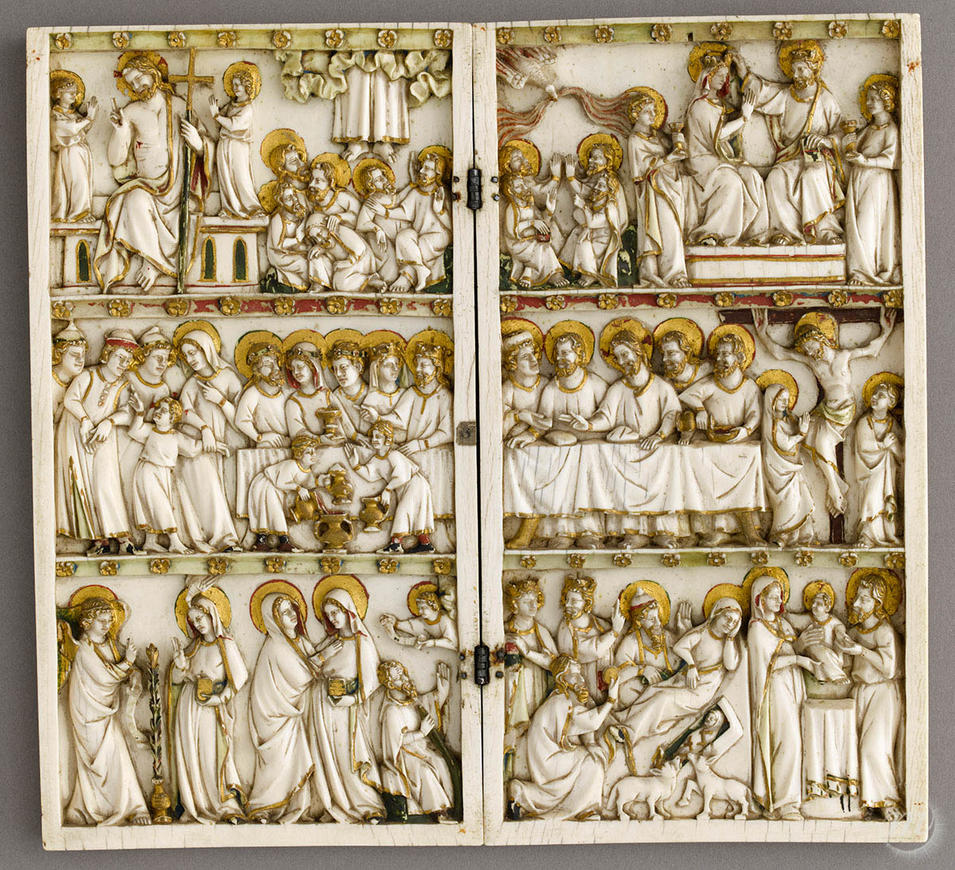This precious object, made of ivory decorated with gold and paint, is a portable altarpiece in two parts, called a diptych. It folds together with silver hinges. A large number of diptychs were produced in Paris workshops between the late 13th century and end of the 14th. The capital of the Kingdom of France was then the most important manufacturing centre for elephant ivory works in the West! These objects, commissioned by wealthy clients for private use, could be used for both religious and secular purposes. But in most cases, they depicted religious scenes, as seen here.
The story continues from one panel to the next. Like a comic strip, it reads from left to right, but surprisingly, from bottom to top! So we need to begin with the scenes from the lower register: the Annunciation, Visitation, Joseph's Dream, the Adoration of the Magi, and the Presentation of Jesus at the Temple.
Let's go up a notch: here is Jesus among the Doctors of the Temple, the Wedding at Cana, the Last Supper and, finally, Jesus on the cross... It’s the Crucifixion.
On the upper level, the Resurrection, Ascension, Pentecost and Coronation of the Virgin conclude this very special comic strip!
Detail 1: The composition is carefully considered. As such, the table set for the Wedding at Cana scene continues in the second part with the Last Supper. The two episodes seem to be one, even though Christ is depicted in both.
Detail 2: The sculptor adapted to the constraints of the material by modifying the scale of the figures: Joseph, to whom an angel announces the birth of Christ in a dream, is represented in reduced format. In this way, he can occupy the small space left free at the bottom of the left panel.
Inv. A 102

This precious object, made of ivory decorated with gold and paint, is a portable altarpiece in two parts, called a diptych. It folds together with silver hinges. A large number of diptychs were produced in Paris workshops between the late 13th century and end of the 14th. The capital of the Kingdom of France was then the most important manufacturing centre for elephant ivory works in the West! These objects, commissioned by wealthy clients for private use, could be used for both religious and secular purposes. But in most cases, they depicted religious scenes, as seen here.
The story continues from one panel to the next. Like a comic strip, it reads from left to right, but surprisingly, from bottom to top! So we need to begin with the scenes from the lower register: the Annunciation, Visitation, Joseph's Dream, the Adoration of the Magi, and the Presentation of Jesus at the Temple.
Let's go up a notch: here is Jesus among the Doctors of the Temple, the Wedding at Cana, the Last Supper and, finally, Jesus on the cross... It’s the Crucifixion.
On the upper level, the Resurrection, Ascension, Pentecost and Coronation of the Virgin conclude this very special comic strip!
Detail 1: The composition is carefully considered. As such, the table set for the Wedding at Cana scene continues in the second part with the Last Supper. The two episodes seem to be one, even though Christ is depicted in both.
Detail 2: The sculptor adapted to the constraints of the material by modifying the scale of the figures: Joseph, to whom an angel announces the birth of Christ in a dream, is represented in reduced format. In this way, he can occupy the small space left free at the bottom of the left panel.
Inv. A 102